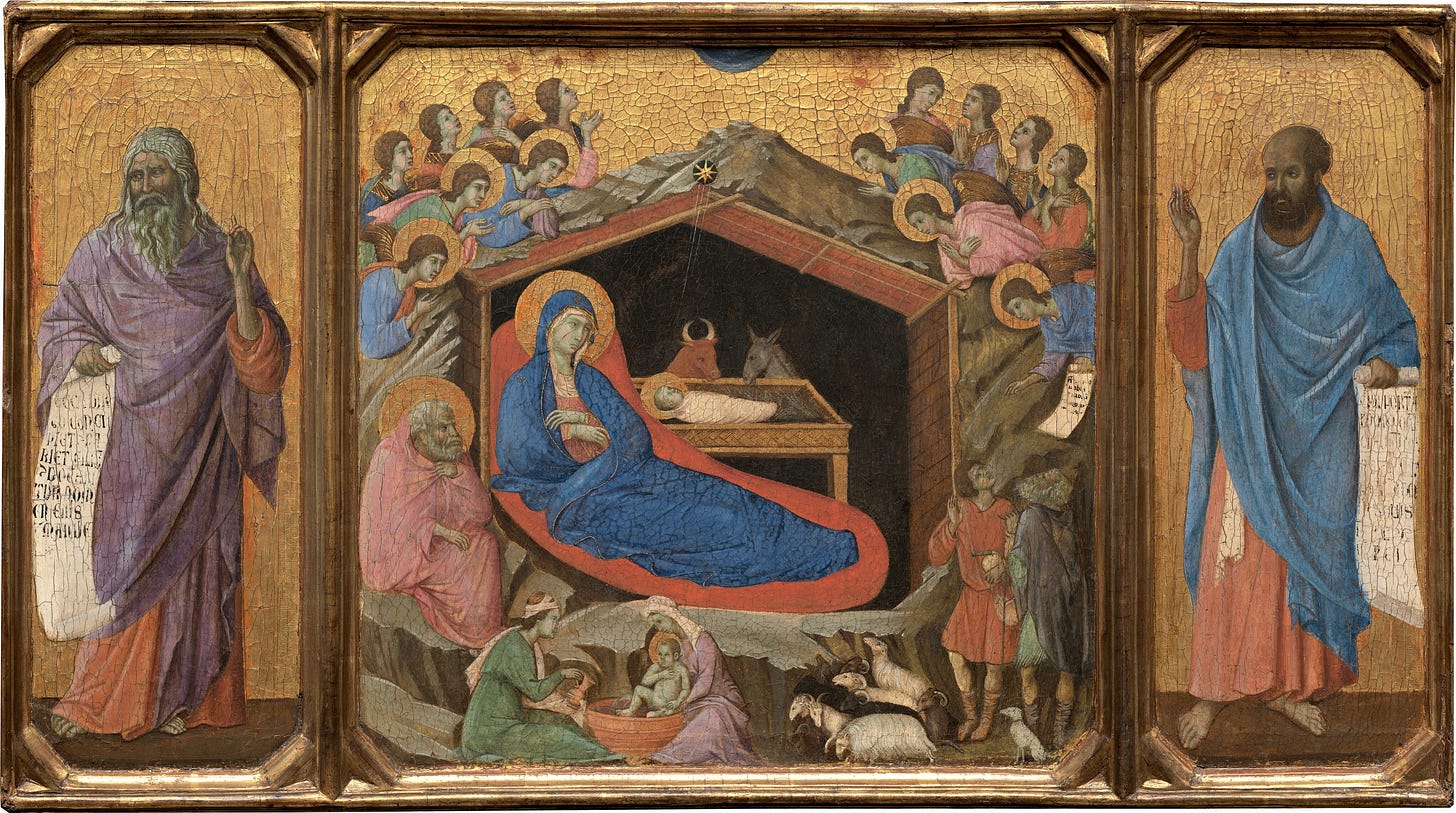A few weeks ago I found my ability to speak clearly on the particulars of the Trinity and hypostatic union rusty at best. I resolved to brush up on this at Advent, figuring it would also fuel worship for the season. So for an afternoon, I whipped out my systematic theologies and soaked in the glorious mystery of Jesus becoming man while remaining fully God.
“Hark, hark, the wise eternal Word Like a weak infant cries; In form of servant is the Lord And God in cradle lies.”²
The Trinity: One Essence, Three Persons
The basic orthodox summary of the Trinity is that the one essence of God has three distinct persons—Father, Son, and Spirit. Each person is distinct so that they communicate with one another, inhabit different roles, and show up side by side (Matt. 28:19). However, while distinct, they do not exist independent of each other but are the same divine essence. Each person is fully God.
Christ: One Person, Two Natures
At Christmas, we celebrate the second person of the Trinity taking on a human nature in addition to his divine nature. Theologians call this the hypostatic union—uniting two natures in one person. The term hypostatic union is the church's attempt to show how Jesus can be fully God and fully man at the same time. Jesus does this by taking on a human nature in addition to his divine nature. He does not lose his divine nature but in addition assumes or takes on a human nature.
(Jesus) “who, though he was in the form of God, did not count equality with God a thing to be grasped, but emptied himself, by taking the form of a servant, being born in the likeness of men” (Phil 2:6-7).
Two Clarifications—Anhypostasis and Enhypostasis
When Jesus takes on human nature he does not take on an additional person. In other words, Jesus takes the form of a man but doesn't take on an additional person. Jesus is not two persons but the one divine person of the Son who takes on a human nature. The term for this is anhypostasis (without person).
The divine Son (person) gives personhood to the human nature he assumes. The person of the divine Son thinks, wills, and acts (things a person does as an active agent) through the human nature (flesh, blood, etc). The person of the divine Son died through his human nature. The second person of the divine essence is the person of Christ's human nature. The term for this is enhypostasis (inpersonal).
LORD, to thy Wisedome nought is, nor thy Might; But that thou shouldst (thy Glorie Laid aside) Come meanelie in mortalitie to bide, And die for those deserv'd eternall plight, A wonder is so farre above our wit, That Angels stand amaz'd to muse on it.³
Two Natures and Two Sets of Attributes
The two natures of Christ do not merge or change one another. Christ's divine nature is unchanging even though Christ assumes a human nature. Each nature of Jesus has its own set of attributes. Christ does not lose his divine attributes when he takes the form of a man. 1 Cor 2:8 shows a good example of this:
8 None of the rulers of this age understood this, for if they had, they would not have crucified the Lord of glory” (1 Cor 2:8)
Jesus could only be crucified in his human nature. Jesus had to take on human nature to taste death for humanity. Jesus experienced hunger, sleep, tears, and many more human experiences on earth. All of these are human attributes. But note who they crucified—the Lord of glory. “Lord of glory” describes the divine nature of Jesus. Human nature would not be described as the Lord of glory.
Precision, Mystery, and Adoration
Theology like this can feel precise: God is one essence with three persons, one of whom takes on an additional human nature that is anhypostasis and enhypostasis with each nature containing its own set of attributes. It's almost like a math problem that we are left trying to solve.
In fact, some might even call it the “problem of the incarnation.” We will always wrestle with mystery no matter how precise we define our terms. The hypostatic union is not a problem to solve with a perfect mathematic solution, but a deep mystery to explore. The more we explore, the more we discover, and the more we discover, the more we worship.
“Come behold the wondrous mystery
In the dawning of the king
He, the theme of Heaven's praises
Robed in frail humanity
In our longing, in our darkness
Now the light of life has come
Look to Christ who condescended
Took on flesh to ransom us.”
The painting seems to forefront a pondering mood. It particularly lacks any sort of joy. Joseph and Mary even look sad and frustrated. It’s when you look at the angels that you see the pondering and worship. Some of the angels are looking down at Jesus with intrigue. One of the angels has a hand over her heart as she gazes down. Some of the other angels turn their gaze upward towards heaven responding with worship. The prophets Isaiah and Ezekiel stand on the side with their prophecies in hand. Jesus had been foretold years before. The painting strikes me as one of pondering and worship. The mystery of the incarnation causes us to ponder and worship God.
Thomas Pestel, Psalm For Chrstmas Day (c. 1584-c. 1659)
Ibid., Sonnet x: Amazement At The Incarnation Of God.




Thank you for sharing this. What a great reminder. Indeed, the glories of who God is will be a perpetual discovery for all eternity - and thus, time itself will serve to exalt Him exponentially. Every moment will be more of a reason for us to worship Him. Indeed, "The more we explore, the more we discover, and the more we discover, the more we worship."